LAB REPORT
Science and Technology Making Headlines
Aug. 11, 2017
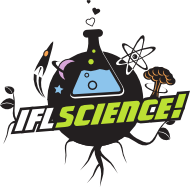

Despite staggering differences in mass and scale of the sun (left), National Ignition Facility implosions (right) are being used to recreate the conditions found in the deep interiors of stars so that they may be better understood.
Aim for the stars
The energy of stars comes from nuclear fusion. At their cores, under incredible pressure and temperature, lighter elements like hydrogen and helium are fused into heavier ones. These conditions are extreme and it's only now that researchers are getting close to replicating them.
Lawrence Livermore researchers used the National Ignition Facility to reproduce what’s happening inside massive stars (those that are 10 to 40 times the mass of our sun) by compressing hydrogen to 1,000 times the density of lead and a temperature of about 90 million degrees Fahrenheit.
In these conditions, hydrogen is turned into an extremely dense and hot plasma. This allowed for nucleosynthesis, the formation of different elements from the fusion of simpler ones.

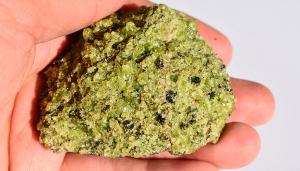
A mantle nodule collected from San Carlos, Arizona, brought to the surface during a deep volcanic eruption about 1 million years ago. Olivine, which is the focus of the LLNL study, is the predominant light green-colored mineral that is present in this rock. Photo by Wyatt Du Frane/LLNL
Journey to the center of the Earth
Scientists at Lawrence Livermore National Laboratory believe their improved understanding of electrical conductivity inside Earth's mantle will help them map the distribution of water inside Earth.
Earth is the only planet in the solar system to develop plate tectonics and large liquid water oceans on its surface. Planetary scientists believe the distribution of significant amounts of water inside Earth's mantle is linked with the two phenomena.
Understanding the diffusion of hydrogen in the mantle is key to measuring the distribution of water inside Earth. Hydrogen plays an important role in encouraging electric conductivity, but researchers haven't been able to accurately quantify the relationship between hydrogen and conductivity.
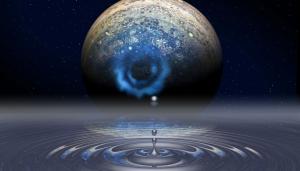
Hydrogen gas bubbles evolve from water at tantalum disulfide electrocatalyst surfaces. Catalytic activity in layered metal dichalcogenides like these is usually limited to edges, but this work reports new materials that also can generate hydrogen at the surfaces. Image by Ryan Chen/LLNL
Water splits, hydrogen shows up
Lawrence Livermore National Laboratory scientists have developed a technique that helps extract hydrogen from water efficiently and cheaply.
Hydrogen can be used as a clean fuel in fuel cells, which produce power, with water and heat as the only byproducts. As a zero-emission fuel, the hydrogen can be recombined with oxygen to produce electric power on demand, such as onboard a fuel-cell vehicle.
The Livermore team and collaborators at Rice University and San Diego State University turned to electricity to produce clean hydrogen fuel by splitting water molecules, which are made of oxygen and hydrogen atoms. The researchers discovered a new class of cheap and efficient catalysts to facilitate the water splitting process.

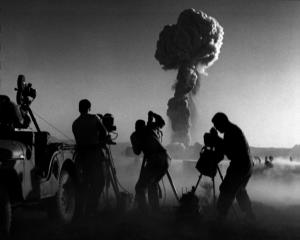
A shallow underground nuclear test conducted by the United States on July 6, 1962 at the Nevada Test Site.
Eavesdropping on North Korea
Earthquake scientists are eavesdropping on North Korea’s nuclear tests by tracking the secretive blasts. But there is only so much scientists can do to understand explosions they can’t get near. That’s where the test blasts in Nevada come in.
The tests were part of phase one of the Source Physics Experiment. The goal was to set off a series of chemical explosions of different sizes and at different depths in the same borehole and then record the seismic signals on a battery of instruments. The detonations took place at the nuclear test site in southern Nevada, where between 1951 and 1992 the U.S. government set off 828 underground nuclear tests and 100 atmospheric ones.
For the Source Physics Experiment, six chemical explosions were set off between 2011 and 2016, ranging up to 5,000 kilograms of TNT equivalent and down to 87 meters deep. The biggest required high-energy–density explosives packed into a cylinder nearly a meter across and 6.7 meters long, said Beth Dzenitis, an engineer at Lawrence Livermorea who oversaw part of the field campaign. Yet for all that firepower, the detonation barely registered on anything other than the instruments peppering the ground. “I wish I could tell you all these cool fireworks go off, but you don’t even know it’s happening,” she says.
The explosives were set inside granite rock, a material very similar to the granite at Mount Mantap. The seismic waves racing outward behaved very much as they might at the North Korean nuclear test site, says William Walter, head of geophysical monitoring at LLNL. The underlying physics, describing how seismic energy travels through the ground, is virtually the same for both chemical and nuclear blasts.

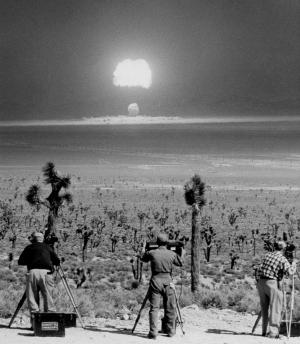
Movies of Operation Teapot is one of the recently declassified films available on YouTube.
Boom shakalaka
The U.S. detonated more than 200 atmospheric nuclear weapons to gather scientific data about their potential. That data was gospel for years, until a weapons physicist decades later found out the figures were off by huge margins.
The fireballs were captured on film by strategically placed cameras all around the test sites and then analyzed by scientists specifically for their yield, or the energy released.
Best scientific data for the nations has for its nuclear potential. But when LLNL weapons physicist Greg Spriggs was asked to write a computer code that would predict with nuclear fallout that just didn’t coincide with the data from the tests. So Spriggs is on a mission to scan and analyze all the old films to make sure the data is up to snuff.





